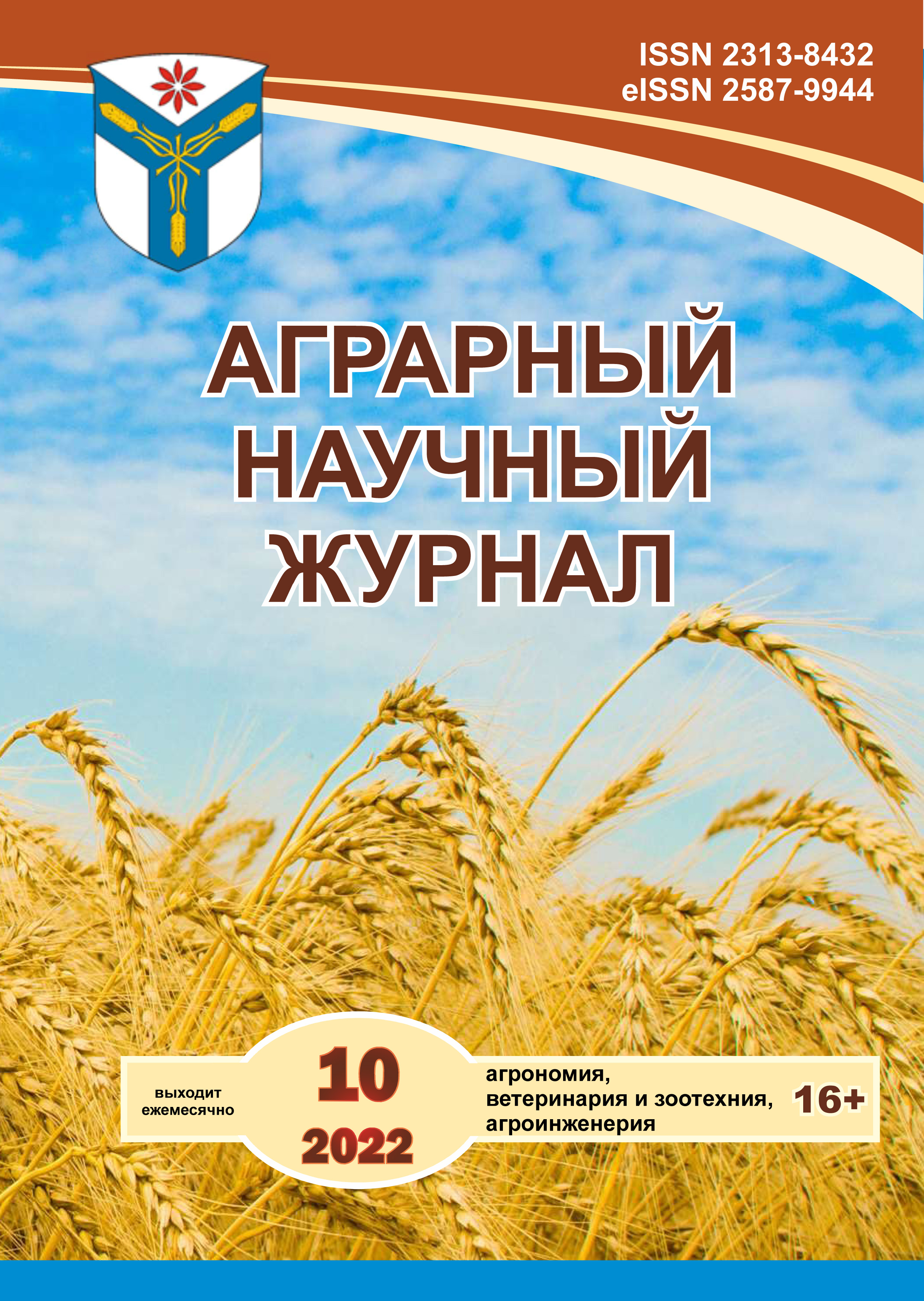Analysis of promising varieties and forms of raspberries of the repair type of fruiting by a complex of signs in the conditions of the Orenburg region
DOI:
https://doi.org/10.28983/asj.y2022i10pp4-9Keywords:
raspberry, variety, shape, feature, Euclidean distanceAbstract
Today, it is important to study the interaction of the genotype of red raspberry plants and climatic conditions. The study included 12 varieties and forms of primocane raspberry selection of the Kokino base station of Federal Horticultural Center for Breeding, Agrotechnology and Nursery and the Orenburg branch of the Federal Horticultural Research Center for Breeding, Agrotechnology and Nursery. The following signs were studied: the number of berries on the lateral, the average weight of the berry, productivity, the content of sugars, soluble solids, ascorbic acid in berries. It was found that the genotype of the variety and form has the greatest influence on the average weight of berries (97.6 %), productivity (79.7 %), soluble dry substances (76.0 %), and the number of berries on the lateral, the content of sugars and ascorbic acid is 60.0-53.0 %. A positive correlation was found between the average weight of berries and productivity (R=0.85). According to the results of clustering, it was revealed that at the level of 20 standard units, two groups are distinguished (in the first - 7 varieties and forms, in the second – 5). The varieties and forms included in the first group had the maximum productivity and average weight of berries in the climatic conditions of the Orenburg region. When comparing the average values of traits using the t - Student criterion, it was revealed that the average berry weight and productivity from the bush had statistical differences between the first and second clusters (t = 4.78 and 4.91 at p<0.01, respectively). Based on the data obtained, it was revealed that more significant differences in Euclidean distances are noted for the varieties Gerakl – 0.64, Jar ptica – 0.59, Arisha – 0.57, Oranjevoe chudo – 0.46, 1-80 – 0.43, which realized their productivity potential in different years of cultivation and are of interest both for cultivation in the conditions of the Orenburg region and for their further use in breeding.
Downloads
References
Annicchiarico P. Additive main effects and multiplicative interaction (AMMI) analysis of genotype-location interaction in variety trials repeated over years // Theor. Appl. Genet. 1997. No. 94. Р. 1072-1077.
Burrows C. & Moore P. R. genotype x environmental influence on raspberry fruit quality // Acta Horti. 2002. No. 585. Р. 467-473.
Gabriel A., Resende J. T. V., Zeist A. R., Resende L. V., Resende N. C. V., Galv?o A. G., Zeist R. A., Lima Filho R. B., Corr?a J. V. W., Camargo C. K. Phenotypic stability of strawberry cultivars assessed in three environments // Gen. Mol. Res. 2018. No. 17(3). Р.1-11.
Hancock R. D., Petridis A., McDougall G. J. Raspberry fruit chemistry in relation to fruit quality and human nutrition // In: Graham J., Brennan R. (eds) Raspberry. Springer, Chem. 2018. Р. 89-119.
Kris-Etherton P. M., Hecker K. D., Bonanome A., Coval S. M., Binkoski A. E., Hipert K. F. et al. Bioactive compounds in food; their role in the prevention of cardiovascular diseases and cancer // American Journal of Medicine. 2002. No. 113. Р. 71-88.
Weber C. & Lui R. H. Antioxidant capacity and antioxidant properties of red raspberries // Acta Horti. 2002. No. 585. Р. 451-455.
Аминова Е.В., Авдеева З.А., Мережко О.Е. Перспективные формы малины в условиях Оренбургской области // Плодоводство и ягодоводство России. 2017. Т.51. С.116-120.
Аминова Е.В., Иванова Е.А., Мурсалимова Г.Р. Оценка форм ремонтантной малины в орошаемых условиях степной зоны Приуралья // Плодоводство и ягодоводство России. 2019. Т.56. С. 35-39.
Евдокименко С. Н. Селекционный потенциал рода Rubus // Плодоводство и ягодоводство России. 2016. Т.46. С. 101-104.
Евдокименко С. Н., Кулагина В. Л., Якуб И. Я. Современные тенденции производства и селекции малины // Плодоводство и ягодоводство России. 2012. Т.31(1). С. 148-156.
Жанг Д. Х., Тохтарь В. К. Исследование засухоустойчивости перспективных для интродукции видов Momordica сharantia L. и M. balsamina L. (Cucurbitaceae) // Научные ведомости Белгородского государственного университета. Серия: естественные науки. 2011. № 9 (104). Выпуск 15. С. 43-47.
Жбанова Е.В. Плоды малины RUBUS IDAEUS L. как источник функциональных ингредиентов (обзор) // Техника и технология пищевых производств. 2018. №48(1). С. 5-14
Кичина В. В. Крупноплодные малины России. М. 2005. 208 с.
Лапшин, В.И., Яковенко, В.В., Щеглов, С.Н., Подорожный, В.Н. Методический подход к оценке изменчивости признаков продуктивности и качества ягод в генетических коллекциях земляники садовой (Fragaria ? ananassa Duch.) // Вавиловский журнал генетики и селекции. 2019. №23(6). С. 675-682.
Лашин С.А., Афонников Д.А., Генаев М.А., Казанцев Ф.В., Комышев Е.Г., Ощепкова Е.А., Петров А.В., Рассказов Д.А., Смирнова А.А., Колчанов Н.А. Информационная система по биоресурсным коллекциям институтов ФАНО России // Вавиловский журнал генетики и селекции. 2018. №22(3). С. 386-393.
Подгаецкий М. А., Евдокименко С. Н. Селекционная оценка исходных форм малины по крупноплодности // Садоводство и виноградарство. 2021. №1. С. 16-22.
Потанин В. Г., Алейников А. Ф., Стёпочкин П. И. Новый подход к оценке экологической пластичности сортов растений // Вавиловский журнал генетики и селекции. 2014. №18(3). С. 548-552
Программа и методика сортоизучения плодовых, ягодных и орехоплодных культур. Орел: ВНИИСПК. 1999. 608 с.
Downloads
Published
Issue
Section
License
Copyright (c) 2022 The Agrarian Scientific Journal

This work is licensed under a Creative Commons Attribution-NonCommercial-NoDerivatives 4.0 International License.








